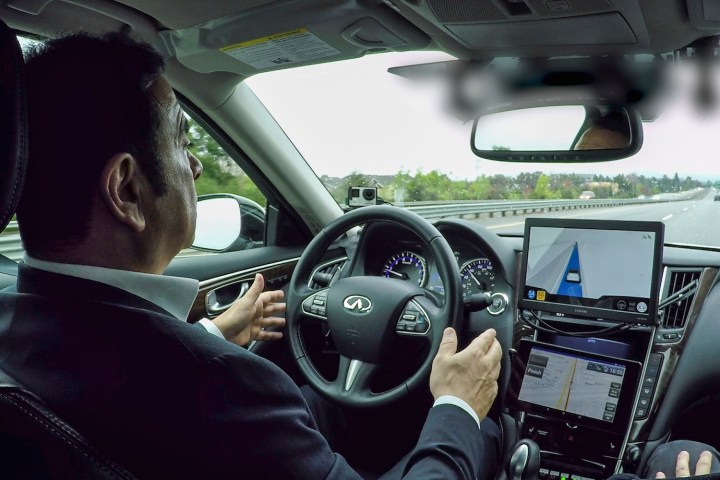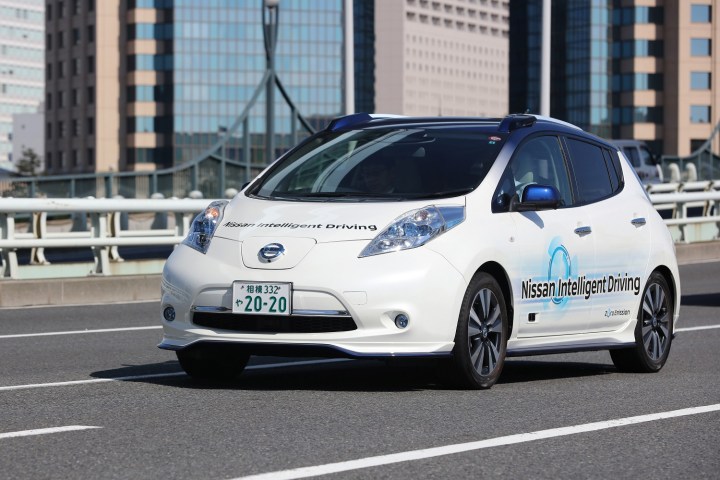
Seamless Autonomous Mobility (SAM)
SAM has been designed to address autonomous vehicle reactions to unpredictable situations – one of the biggest obstacles to self-driving tech. The system will be used to recognize situations where the autonomous vehicle should NOT act on its own. In the instance of an accident, for example, where police officers are directing traffic over yellow lines, or in other ways that go against an autonomous car’s programming, SAM will safely pause the vehicle and request human commands.
Here’s where it gets interesting. In this situation, SAM isn’t asking for the car’s passengers to act, but rather an available “mobility manager” (presumably some standby operator patched in through Wi-Fi). This manager will then assess the situation and craft a virtual lane for the car to trek. Once past the obstacle, the mobility manager will return control to the vehicle’s computer. This process is then communicated to other autonomous vehicles so they can follow the same route (and avoid engaging other mobility managers).
SAM is modeled after NASA’s Visual Environment for Remote Virtual Exploration (VERVE) software, which is used to visualize and supervise interplanetary robots.
“Our goal is to change the transportation infrastructure,” said Maarten Sierhuis, former NASA scientist and director of the Nissan Research Center in Silicon Valley. “We want to reduce fatalities and ease congestion. We need a huge number of vehicles out there. What we are doing at Nissan is finding a way so that we can have this future transportation system, not in 20 years or more, but now.”
Driverless commercial vehicles
Renault-Nissan will partner with DeNA, a Japanese internet company, to begin testing driverless vehicles for commercial services. The initial tests will start this year in Japan, and by 2020, the two entities hope to expand tests to commercial usage in Tokyo’s metropolitan area.

Renault-Nissan will provide the vehicles and autonomous software, and DeNA will build a mobility service platform. The collaboration plans to launch tests in the U.S., Europe, China, and Japan.
Next-generation Nissan Leaf
Nissan has also given a preview of some of the next-generation Leaf’s onboard technology. Highlighting the electric vehicle’s features will be ProPILOT, an autonomous driving function for single-lane highways. We don’t know exactly when to expect the new Leaf, but given the rapid growth of competition, it’s likely that Nissan is putting a rush on this model. Working in the car’s favor is a giant consumer base — to date, the Leaf has worldwide sales of more than 250,000.
Microsoft connected car tech
Renault-Nissan is furthering its partnership with Microsoft to build new connected car applications. Microsoft’s Cortana personal assistant will be used to improve convenience features for all passengers. Cortana will also let the car adapt to personalized driver settings, even understanding different driver preferences in a shared vehicle.
Nissan partners with 100 Resilient Cities
Nissan is partnering with 100 Resilient Cities, a global nonprofit that helps cities build resilience to physical, social, and economic challenges. The collaboration will help cities prepare for autonomous driving, EVs, and new mobility services.
“The partnership between 100RC and Nissan will begin priming cities for new automotive technology, while creating better mobility for citizens, and building long-term resilience to the shocks and stresses cities may face,” said Ghosn.
Editors' Recommendations
- Volkswagen is launching its own self-driving car testing program in the U.S.
- Nissan employs certified smellers to check the odor of its new cars
- Samsung’s Digital Cockpit is a futuristic concept for self-driving car interiors
- Waymo puts its self-driving cars back on Arizona roads as lockdown is eased
- Qualcomm’s self-driving car made me never want to touch a steering wheel again


